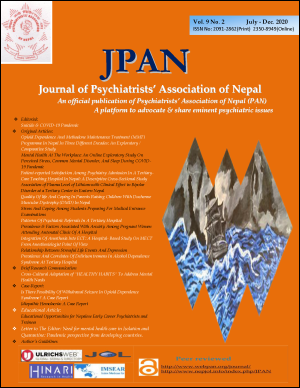Patterns Of Psychiatric Referrals In A Tertiary Hospital
DOI:
https://doi.org/10.3126/jpan.v9i2.36284Keywords:
Consultation-Liaison Psychiatry, Psychiatric Referrals, Tertiary Care HospitalAbstract
Introduction: Consultation-Liaison Psychiatry (CLP) is a subspecialty of psychiatry that provides care to patients under non-psychiatric care. Despite evidence of benefits of CLP for patients with psychiatric comorbidities, referral rates from hospital doctors remain low. This has prompted the present study, to assess the frequency and the pattern of psychiatric referral in a tertiary hospital in Nepal.
Material And Method: This was a descriptive cross‑sectional study conducted in a tertiary care hospital. The study comprised of 108 patients referred for psychiatric consultation from various out-patient departments (OPD) to C‑L services of psychiatry department. Information was collected using semi‑structured proforma, and diagnosis was made based on Diagnostic Criteria for Research (ICD-10 DCR)and the data were analyzed.
Results: A total of 108 patients, male 41(38%) and female: 67(62%) were referred to CLP, the Medicine department sent the maximum number of consultations (57.4%), followed by E.N.T (25.9%), Surgery (16.7%). Psychiatric consultation was sought for various reasons including decreased sleep (37%), appears anxious (27.8%), appears depressed (15.7%), foreign body sensation (11.1%), and mass moving in abdomen (8.3%).The most prevalent ICD-10 diagnosis was depressive episode (44.4%) followed by anxiety disorder (27.8%) and somatoform disorder (19.4%).
Conclusion: Our study illustrates the importance of CLP through referral pattern from various OPD in a tertiary care hospital. Majority of referrals were from Medicine department andthe most common reason of referral was decreased sleep. The commonest diagnosis seen in the referred out-patients was depression followed by anxiety disorder and somatoform disorder.
Downloads
Downloads
Published
How to Cite
Issue
Section
License
This license enables reusers to distribute, remix, adapt, and build upon the material in any medium or format, so long as attribution is given to the creator. The license allows for commercial use.




